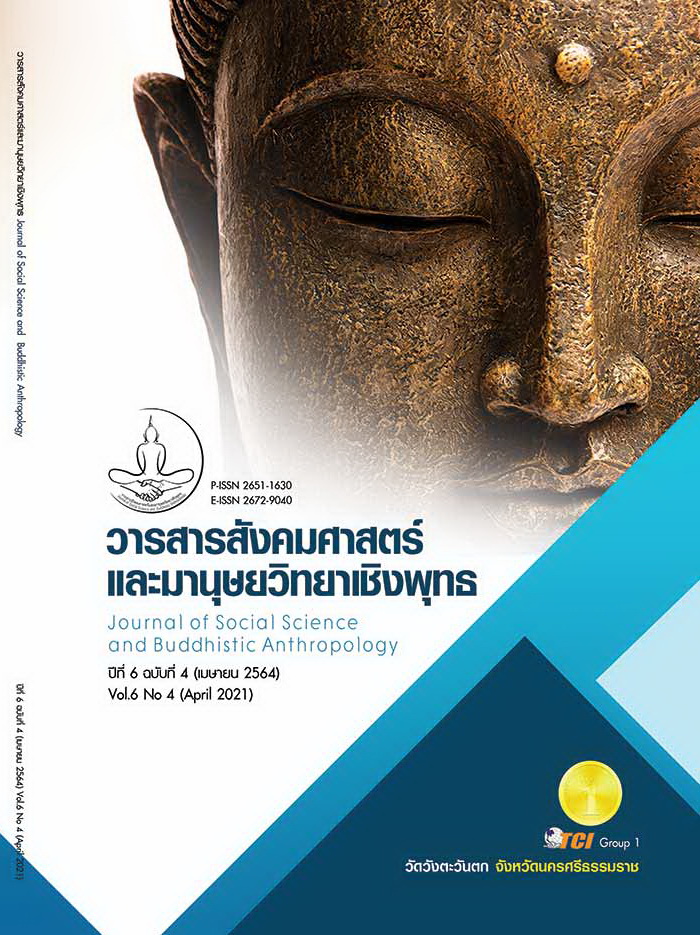THE DEVELOPMENT FORMAT UNDERLYING COMMUNITY SUFFICIENCY ECONOMY MODEL “HAPPINESS COMMUNITY” IN NAKHONSAWAN PROVINCE
Keywords:
The Development Format, The Community Model, Sufficiency Economy, Happiness CommunityAbstract
The objectives of this research article were to 1) study development format underlying community sufficiency economy model “Happiness Community” In Nakhonsawan Province 2) study development process underlying community sufficiency economy model “Happiness Community” in Nakhonsawan Province and 3) build a network of development underlying community sufficiency economy model "Happiness Community" in Nakhonsawan Province. Qualitative research was used, based on action research processes. Selected a model community of Ban Dan Pattana, Village No. 10, Khao Chon Kan Sub-district, Mae Wong District, Nakhon Sawan Province as the research area. For a reason, it received the award for the Sufficiency Economy Village at the provincial level and the 1st runner-up award, "Baan Suay Mueang Suk”, Project of the region level. Data were collected by Interviewing, focus group discussions and observation. Data analysis by analytic induction from interviews and group discussions data, content analysis from document information to get format and process of developing as a model community were used to create a development network with other 3 villages. The results of the research were as follows: 1) There were 2 forms of community development, namely the leader and the Borwon (Ban, Wat, Government). 2) The development process was 6 steps: creating an understanding of development concept and values, creating an understanding of community conditions, analyzed the potential of the community together, established development groups in each field, Continuous development and improvement and built development networks. And also found that the success of community development produces social outcomes; people in the community have good physical and mental health, caring for each other, analyzed problems and development planning together, community society was peaceful, the family was warm, loved in the homeland, proud to be awarded and as a development model for other villages. The economy outcomes; people in the community had a stable career, had enough income for sustenance and money savings. Environment outcomes; the community environment and ecosystem were balanced.
References
เสาวนีย์ อาภามงคล. (2559). ตัวแบบการพัฒนาชุมชนด้วยแนวคิดเศรษฐกิจพอเพียงเอเชียพิจาร ศูนย์การศึกษาเอเชีย. กรุงเทพมหานคร: คณะรัฐศาสตร์ มหาวิทยาลัยรามคำแหง.
ขวัญกมล ดอนขวา. (2557). แบบจำลองปรัชญาของเศรษฐกิจพอเพียง และเศรษฐกิจสร้างสรรค์มีผลต่อการพัฒนาเศรษฐกิจของประเทศไทย. นครราชสีมา: สำนักวิชาเทคโนโลยีสังคม มหาวิทยาลัยเทคโนโลยีสุนารี.
ปาริชา มารี เคน. (2551). บทบาทขององค์กรปกครองส่วนท้องถิ่นต่อการเสริมสร้างความเข้มแข็งของชุมชน กรณีศึกษาเทศบาลตำบลนาคูอำเภอนาคูจังหวัดกาฬสินธุ์. วารสารมหาวิทยาลัยราชภัฏมหาสารคาม, 2(2), 69-78.
พระวัฒธยา ฐิติสมฺปนฺโน. (2560). ความร่วมมือของบ้าน วัด และโรงเรียน ในการพัฒนาสังคม อำเภอวิหารแดง จังหวัดสระบุรี. วารสาร มจร การพัฒนาสังคม, 2(3), 86-101.
วิทยา จันทร์แดง และจำนง อดิวัฒนสิทธิ์. (2555). การพัฒนารูปแบบการบริหารจัดการชุมชนเข้มแข็งตามแนวปรัชญาเศรษฐกิจพอเพียงในเขตจังหวัดภาคกลางตอนบนสักทอง. วารสารการวิจัย, 18(2), 23-40.
วิทูลย์ แก้วสุวรรณ และคณะ. (2559). การพัฒนาชุมชนตามแนวปรัชญาเศรษฐกิจพอเพียงในกลุ่มจังหวัดภาคกลางตอนล่างการเมืองการปกครอง. วารสารการวิจัย, 6(2), 55-66.
สมาน ทำตะคุ. (25 มิถุนายน 2563). พนักงานฝ่ายพัฒนา องค์การบริหารส่วนตำบลเขาชนกัน อำเภอแม่วงก์ จังหวัดนครสวรรค์. (ประเวศน์ มหารัตน์สกุล, ผู้สัมภาษณ์)
สิริกร บุญสังข์ และคณะ. (2560). การพัฒนาชุมชนต้นแบบในการนำแนวคิด เศรษฐกิจพอเพียงมาใช้ เพื่อชุมชนอยู่เย็น เป็นสุข. วารสารชุมชนวิจัย, 11(2), 9-18.
อาคม เติมพิทยาไพสิฐ. (2557). วิสัยทัศน์และยุทธศาสตร์การพัฒนาประเทศ... สู่ความยั่งยืน. กรุงเทพมหานคร: อมรินทร์พริ้นติ้งแอนด์พับลิชชิ่ง.
อุบลรัตน์ สิทธิน้อย. (11 สิงหาคม 2563). พัฒนาการอำเภอแม่วงก์ จังหวัดนครสวรรค์. (ประเวศน์ มหารัตน์สกุล, ผู้สัมภาษณ์)
Appleton, J. V. (1995). Analysing qualitative interview data addressing issues of validity and reliability. Journal of Advanced Nursing, 22(1), 993-997.
Aristotle. (2020). Politics, translated by Benjamin Jowett. Retrieved November 20, 2020, from http://classics.mit.edu/Aristotle/politics.html.
Dukes, S. (1984). Phenomenology Methodology in the Human Sciences. Journal of Religion and Health, 23(3), 197-203.
Greenwood, D. & Levin, M. (2001). Pragmatic action research and the struggle to transform universities into learning communities. London: Sage.
Kemmis, S. & Mc Taggart, R. (1988). The Action Research Planer 3rd ed. Victoria: Deakin University.
Markusen, A. (2004). “Targeting Occupations in Regional and Community Economic Development”. Journal of the American Planning Association, 70(3), 253 - 268.
Merriam, S. B. (2009). Qualitative Research : A Guide to design and implementation. San Francisco: Jossey- Bass.
Williamson, T. & Long, A. F. (2005). Qualitative data analysis using data display. Nurse Researcher, 12(3), 7-19.








